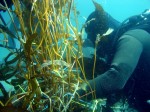Satellite technology is enabling marine scientists at the Santa Barbara Coastal (SBC) LTER site to study how environmental factors and climate affect the giant kelp forests off the coast of California. The giant kelp (Macrocystis pyrifera) forests are a feature of most temperate coastal regions and are among the most productive ecosystems on earth, providing food and habitat for numerous ecologically and economically important marine species.
In a recent paper entitled "Environmental controls of giant-kelp biomass in the Santa Barbara Channel, California" in the journal Marine Ecology Progress Series, SBC scientists Kyle Cavanaugh, David Siegel, and Dan Reed, and University of Utah geography professor, Philip Dennison, report the result of 25 years of observations that merge traditional methods of studying giant kelp forests (e.g. scuba diving) and images from the Landsat Thematic Mapper satellite, which allow scientists to observe changes in giant kelp across hundreds of miles off California's Santa Barbara Channel.
For more information, see http://www.nsf.gov/discoveries/disc_summ.jsp?cntn_id=119642&org=NSF

 Enlarge this image
Enlarge this image